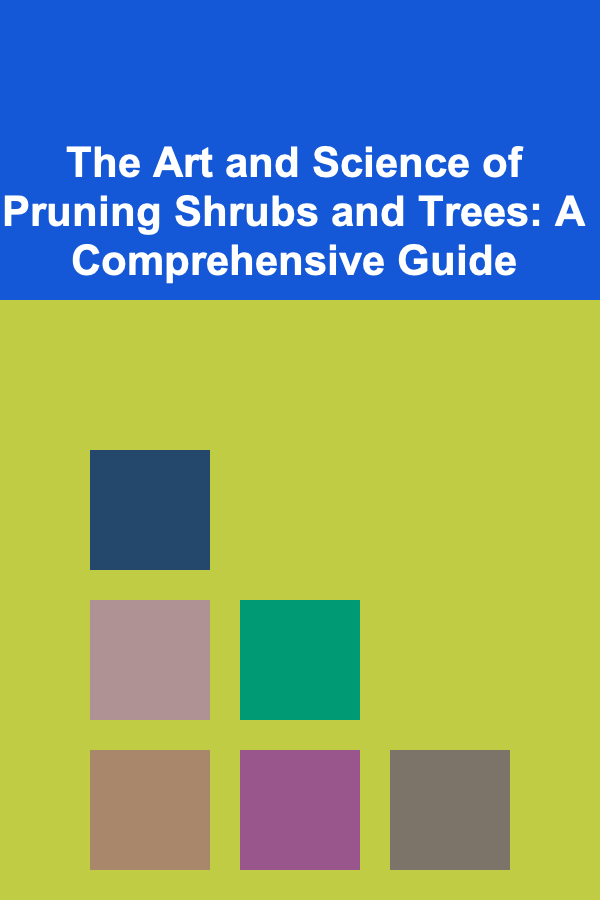
The Art and Science of Pruning Shrubs and Trees: A Comprehensive Guide
ebook include PDF & Audio bundle (Micro Guide)
$12.99$10.99
Limited Time Offer! Order within the next:

Pruning is an essential horticultural practice that involves the selective removal of plant parts, such as branches, buds, or roots. It's a fundamental technique for maintaining the health, aesthetics, and productivity of shrubs and trees. While it might seem like simply cutting off branches, effective pruning is a delicate balance between art and science, requiring a deep understanding of plant physiology, growth habits, and specific pruning techniques. This guide provides an in-depth look at the principles and practices of pruning, equipping you with the knowledge to confidently care for your woody plants.
Why Prune? The Benefits Unveiled
Pruning serves a multitude of purposes, contributing to the overall well-being and beauty of your landscape. Understanding these benefits is the first step in mastering the art of pruning.
- Health and Vigor: Removing dead, diseased, or damaged branches promotes plant health by preventing the spread of infection and redirecting energy to healthy growth. Poorly structured branches that rub against each other create wounds, which are entry points for pests and diseases. Pruning eliminates these vulnerable areas.
- Aesthetics and Shape: Pruning can shape shrubs and trees to enhance their aesthetic appeal and fit their surroundings. This includes creating desired forms, controlling size, and promoting balanced growth. Think of topiary, espalier, and simply maintaining a natural, pleasing shape.
- Flower and Fruit Production: In many flowering and fruiting plants, pruning stimulates the production of blooms and fruit. Removing old or unproductive wood encourages the growth of new, fruitful branches. Different plants flower on different year's wood, so knowing this is vital to getting fruit or flowers.
- Safety: Removing hazardous branches that could fall and cause damage or injury is a crucial safety measure. This is especially important for trees near buildings, power lines, or walkways.
- Air Circulation and Sunlight Penetration: Opening up the canopy through pruning improves air circulation and sunlight penetration, which helps prevent fungal diseases and promotes healthy growth throughout the plant. Dense canopies can trap moisture, creating a breeding ground for pathogens.
- Rejuvenation: Overgrown or neglected shrubs can be rejuvenated through heavy pruning, stimulating new growth and restoring their vigor. This often involves cutting back older, less productive stems to the ground.
Understanding Plant Physiology: The Foundation of Pruning
Before you pick up your pruning shears, it's crucial to understand the basic principles of plant physiology that govern how plants respond to pruning. This knowledge will help you make informed decisions and avoid damaging your plants.
- Apical Dominance: This is the phenomenon where the terminal bud (the bud at the tip of a branch) suppresses the growth of lateral buds (buds along the sides of the branch). Removing the terminal bud through pruning releases the lateral buds, stimulating them to grow and creating a bushier plant.
- Bud Orientation: Buds on a branch point in a particular direction. New growth will typically emerge in that direction. Pruning just above a bud can influence the direction of new growth, allowing you to shape the plant.
- Wound Response: When a branch is cut, the plant initiates a wound-sealing process to prevent infection and water loss. Proper pruning techniques minimize the size of the wound and promote rapid healing. Avoid leaving stubs, which can decay and become entry points for pathogens. Similarly, avoid flush cuts, which can damage the branch collar.
- Plant Hormones: Plant hormones, such as auxins and cytokinins, play a crucial role in growth and development. Pruning affects the balance of these hormones, influencing factors like shoot growth, root development, and flower initiation.
- Photosynthesis and Energy Allocation: Pruning removes photosynthetic tissue, reducing the plant's ability to produce energy. Therefore, it's essential to prune judiciously and avoid removing excessive amounts of foliage. Understand how the plant allocates energy between roots, shoots, and reproduction will help to ensure pruning does not cause undue stress.
The Right Tools for the Job: Ensuring Clean and Efficient Cuts
Using the correct tools is essential for making clean cuts that heal quickly and prevent the spread of diseases. Invest in high-quality tools and maintain them properly to ensure optimal performance.
- Hand Pruners (Secateurs): Ideal for small branches up to ¾ inch in diameter. There are two main types: bypass pruners (which cut like scissors) and anvil pruners (which have a blade that cuts against a flat surface). Bypass pruners are generally preferred because they make cleaner cuts that are less likely to crush the branch.
- Loppers: Used for branches up to 2 inches in diameter. Loppers provide more leverage than hand pruners, making it easier to cut thicker branches. Choose loppers with long handles for reaching higher branches.
- Pruning Saw: Necessary for branches thicker than 2 inches in diameter. Pruning saws have specially designed blades that cut efficiently through wood. Choose a saw with a comfortable handle and appropriate blade length for the size of branches you'll be cutting.
- Pole Pruner: Allows you to reach high branches without a ladder. Pole pruners typically have a cutting head that can be operated from the ground using a rope or other mechanism.
- Hedge Trimmer: Used for shaping hedges and shrubs with many small branches. Hedge trimmers come in both electric and gas-powered models.
Tool Maintenance:
- Clean your tools after each use with a solution of rubbing alcohol or bleach to prevent the spread of diseases.
- Sharpen your blades regularly to ensure clean cuts. A dull blade can tear and damage branches, making them more susceptible to infection.
- Lubricate moving parts to keep your tools operating smoothly.
Basic Pruning Techniques: Mastering the Art of the Cut
Understanding the different types of pruning cuts is essential for achieving the desired results. Here are some of the most common pruning techniques:
- Thinning Cuts: These cuts remove an entire branch back to its point of origin (either a main branch or the trunk). Thinning cuts promote air circulation and sunlight penetration without stimulating excessive new growth. This results in a more open and natural appearance.
- Heading Cuts: These cuts shorten a branch by cutting it back to a bud or a lateral branch. Heading cuts stimulate vigorous new growth near the cut, resulting in a denser, bushier plant. However, excessive heading cuts can lead to a dense, unnatural appearance and weaken the plant's structure.
- Renewal Pruning: This technique is used to rejuvenate overgrown shrubs by removing a significant portion of the oldest stems at ground level. This encourages new growth from the base of the plant.
- Rejuvenation Pruning: Similar to renewal pruning but more drastic. All stems are cut back severely, sometimes to just a few inches above the ground. This is typically used as a last resort for severely neglected shrubs.
- Deadheading: The removal of spent flowers. Deadheading encourages repeat blooming and prevents the plant from putting energy into seed production.
- Pinching: Removing the tips of new shoots. Pinching is often used to encourage branching and create a bushier habit in young plants.
Making the Right Cut:
- Identify the Branch Collar: The branch collar is the swollen area at the base of the branch where it connects to the trunk.
- Locate the Branch Bark Ridge: The branch bark ridge is the raised area of bark on the upper side of the branch where it meets the trunk.
- Make the Cut: Make the cut just outside the branch collar and branch bark ridge, at a slight angle. Avoid cutting into the branch collar or leaving a stub. The cut should be clean and smooth.
Proper pruning cut diagram. Note the angle and proximity to the branch collar.
Timing is Everything: When to Prune Different Shrubs and Trees
The timing of pruning can significantly impact a plant's health, growth, and flowering. Knowing when to prune different types of shrubs and trees is crucial for maximizing the benefits of pruning.
- Dormant Pruning (Late Winter/Early Spring): This is the most common time to prune many deciduous trees and shrubs. Plants are dormant, so they are less susceptible to stress and disease. Dormant pruning allows you to easily see the plant's structure and make precise cuts. It also encourages vigorous new growth in the spring. However, avoid pruning spring-flowering shrubs during this time, as you may remove flower buds.
- After Flowering (Late Spring/Early Summer): Spring-flowering shrubs, such as forsythia, lilac, and azalea, should be pruned immediately after they finish flowering. This allows them to set flower buds for the following year. Pruning these shrubs in the late winter or early spring will remove flower buds and reduce flowering.
- Summer Pruning: Summer pruning can be used to slow growth, shape plants, and remove dead or diseased branches. It's best to avoid heavy pruning during the summer, as this can stress the plant during hot weather.
- Fall Pruning: Fall pruning is generally not recommended, as it can stimulate new growth that is vulnerable to frost damage. However, you can remove dead, diseased, or damaged branches in the fall.
General Guidelines:
- Spring-Flowering Shrubs: Prune after flowering.
- Summer-Flowering Shrubs: Prune in late winter or early spring.
- Deciduous Trees: Prune in late winter or early spring.
- Evergreen Trees: Prune in late winter or early spring, or lightly in the summer.
Tip: If you're unsure about the best time to prune a particular plant, consult a local nursery or arborist.
Pruning Specific Types of Shrubs and Trees: A Tailored Approach
Different types of shrubs and trees have different growth habits and pruning needs. Here's a guide to pruning some common types of woody plants:
Flowering Shrubs
- Forsythia: Prune immediately after flowering by removing older, weaker stems.
- Lilac: Prune immediately after flowering by removing spent flower heads and thinning out older stems.
- Azalea/Rhododendron: Prune lightly after flowering to remove spent flower heads and shape the plant. Avoid heavy pruning, as this can reduce flowering.
- Hydrangea (Hydrangea macrophylla - bigleaf): These hydrangeas bloom on old wood (growth from the previous year). Only prune dead or damaged wood. Avoid pruning heavily, as this will remove flower buds.
- Hydrangea (Hydrangea paniculata - panicle): These hydrangeas bloom on new wood (growth from the current year). Prune in late winter or early spring to shape the plant and encourage vigorous new growth. 'Limelight' is a popular panicle hydrangea.
- Hydrangea (Hydrangea arborescens - smooth): Similar to H. paniculata, these bloom on new wood and can be pruned in late winter or early spring. 'Annabelle' is a popular smooth hydrangea.
- Rose of Sharon (Hibiscus syriacus): Prune in late winter or early spring to shape the plant and remove dead or weak branches.
Deciduous Trees
- Maple (Acer): Prune in late winter or early spring to remove dead, diseased, or crossing branches. Avoid heavy pruning, as this can weaken the tree.
- Oak (Quercus): Prune in late winter or early spring to remove dead, diseased, or crossing branches. Oak trees are susceptible to oak wilt, so it's important to avoid pruning them during the growing season.
- Fruit Trees (Apple, Pear, Cherry, Plum): Pruning fruit trees is essential for maximizing fruit production. Prune in late winter or early spring to remove dead, diseased, or crossing branches and to shape the tree for optimal sunlight penetration. Specific pruning techniques vary depending on the type of fruit tree.
- Crabapple (Malus): Prune in late winter or early spring to remove dead, diseased, or crossing branches. Thinning cuts are particularly important for crabapples to improve air circulation and prevent diseases.
Evergreen Trees
- Pine (Pinus): Prune in late winter or early spring to remove dead, diseased, or damaged branches. You can also prune candle growth (new growth) in the spring to control the tree's size and shape.
- Spruce (Picea): Prune in late winter or early spring to remove dead, diseased, or damaged branches. Avoid heavy pruning, as this can disfigure the tree.
- Arborvitae (Thuja): Prune lightly in late winter or early spring to shape the plant and remove dead or damaged branches. Avoid cutting back into old wood, as this will not regenerate.
- Yew (Taxus): Yews are very tolerant of pruning and can be pruned at almost any time of year. They can be shaped into hedges or other formal shapes.
Common Pruning Mistakes to Avoid: Learning from Others' Errors
Even experienced gardeners can make pruning mistakes. Here are some common errors to avoid:
- Topping Trees: Topping is the indiscriminate cutting back of tree branches to stubs. This is a very damaging practice that weakens the tree, makes it more susceptible to disease, and creates an unnatural and unsightly appearance. Never top a tree.
- Leaving Stubs: Leaving stubs when pruning creates entry points for pests and diseases. Always make clean cuts just outside the branch collar.
- Making Flush Cuts: Making flush cuts removes the branch collar, which is essential for proper wound healing. This can weaken the tree and make it more susceptible to disease.
- Pruning at the Wrong Time: Pruning at the wrong time of year can remove flower buds, stimulate unwanted growth, or stress the plant.
- Using Dull Tools: Dull tools tear and damage branches, making them more susceptible to infection. Always use sharp, well-maintained tools.
- Over-Pruning: Removing too much foliage can weaken the plant and reduce its ability to photosynthesize. Prune judiciously and avoid removing more than one-third of the plant's foliage at any one time.
- Improperly Identifying Branches: Cutting off the wrong branches, especially on fruit trees, can significantly reduce fruit production. Carefully identify the branches you want to remove before making any cuts.
Pruning for Specific Goals: Shaping Your Landscape
Pruning can be used to achieve specific landscape goals, such as creating privacy screens, espaliered trees, or topiary.
- Privacy Screens: Hedges of evergreen trees or shrubs can be used to create privacy screens. Regular pruning is necessary to maintain the desired shape and density.
- Espalier: Espalier is the art of training trees or shrubs to grow flat against a wall or fence. Regular pruning and training are required to maintain the desired shape.
- Topiary: Topiary is the art of shaping plants into ornamental shapes. Regular pruning is required to maintain the desired shape.
Beyond the Basics: Resources for Further Learning
This guide provides a comprehensive overview of pruning techniques, but there's always more to learn. Here are some resources for further learning:
- Local Nurseries: Local nurseries are a great source of information on pruning specific plants in your area.
- Arborists: Certified arborists are trained professionals who can provide expert advice on tree care, including pruning.
- University Extension Services: University extension services offer a wealth of information on horticultural practices, including pruning.
- Books and Online Resources: Numerous books and online resources are available on pruning techniques.
Conclusion: Embracing the Art of Pruning
Pruning is a vital practice for maintaining the health, beauty, and productivity of your shrubs and trees. By understanding the principles of plant physiology, using the right tools, and mastering the basic pruning techniques, you can confidently care for your woody plants and create a thriving landscape. Remember to always prune with a purpose, and don't be afraid to experiment and learn from your experiences. The art of pruning is a journey of continuous learning and refinement, and the rewards are well worth the effort.

How to Clean Your Shower Without Scrubbing for Hours
Read More
How to Create a Scrapbook for Your DIY Inspirations
Read More
How to Organize Your Podcast Library for Easy Listening
Read More
How to Secure Your Garage and Shed from Intruders
Read More
How to Use Floor Lamps to Add Warmth to Any Room
Read More
How to Control Portion Sizes Effectively
Read MoreOther Products

How to Clean Your Shower Without Scrubbing for Hours
Read More
How to Create a Scrapbook for Your DIY Inspirations
Read More
How to Organize Your Podcast Library for Easy Listening
Read More
How to Secure Your Garage and Shed from Intruders
Read More
How to Use Floor Lamps to Add Warmth to Any Room
Read More